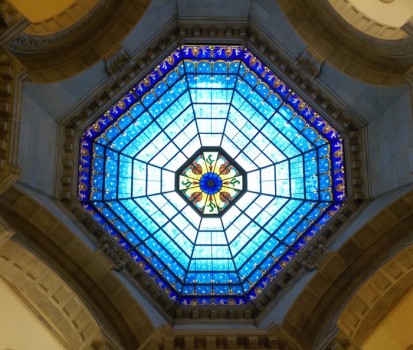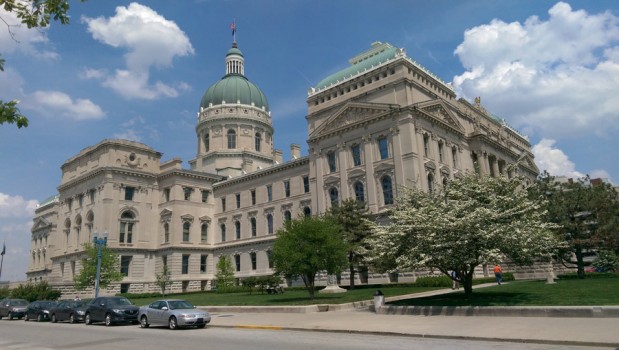Indiana at 200 — Capitol Is A Gathering Place For Hoosiers
By ANDREA NEAL
 The most poignant moments in Indiana history have taken place under its dome and on its front steps.
The most poignant moments in Indiana history have taken place under its dome and on its front steps.
Suffragettes lobbied for the right to vote.
Mourners filed past the casket of President Benjamin Harrison to pay last respects.
Actress Carole Lombard raised the American flag and sold war bonds the day before her untimely death in a plane crash.
Union members jammed the halls to protest repeal of a prevailing-wage law.
From its official opening in 1888 to the eve of the Indiana bicentennial in 2016, the Indiana Statehouse has been a gathering place for Hoosiers of all political stripes.
The three branches of government have offices there: executive, legislative and judicial. So do the news media. In a way, so does the public.
![]() During the legislative session, citizens observe action from the balconies or hallways. Groups schedule Statehouse space for meetings, award ceremonies, receptions, rallies and displays. Tours set off from the information desk near the Rotunda from 9 a.m. to 3 p.m. daily.
During the legislative session, citizens observe action from the balconies or hallways. Groups schedule Statehouse space for meetings, award ceremonies, receptions, rallies and displays. Tours set off from the information desk near the Rotunda from 9 a.m. to 3 p.m. daily.
“The Statehouse belongs to everyone, and as long as the metal detector allows you in, you have the right to absorb as much of its majesty as you can take,” says Donovan Wheeler, a Greencastle High School English teacher who takes his seniors on a field trip to the Capitol every year.
The first thing visitors are reminded of is that Indianapolis was not the original capitol. Corydon claimed that distinction until 1825, when the Legislature moved the seat of government to Indianapolis in order to be closer to the population center, which had gravitated north in the years since statehood.
The General Assembly at first met at the Marion County Courthouse while other state offices operated out of houses and storefronts.
The Legislature approved construction of a capitol in 1832 to be built on the south end of the present site, facing Washington Street. Completed in 1835 for $60,000, this Statehouse was made of brick, wood and stucco in Greek Revival style with porticos on both ends modeled after the Greek Parthenon.
In 1867, the ceiling of the House chamber collapsed. Although it was repaired, lawmakers worried about the building’s long-term safety. In 1877, the Legislature passed a law authorizing construction of a new capital with the process to be overseen by a board of Statehouse commissioners at a cost not to exceed $2 million.
The board held a contest to select the architect and chose Edwin May from Indianapolis out of more than 20 submissions.
His design drew heavily on the national capitol building — a classical Renaissance revival style, with a central domed rotunda and the House and Senate chambers on opposite sides.
May died in 1880. His draftsman, Adolph Scherrer, succeeded him as supervising architect. Legal and contractual disputes and limestone delivery problems delayed the project from time to time; nonetheless, it was finished in 1888 slightly under budget, to the delight of legislators.
Although construction was still underway, the General Assembly convened there on Jan. 6, 1887, and discovered “a monumental, stately and fireproof edifice,” with Corinthian columns, grand courts with skylights and abundant natural light, writes James A. Glass in “The Encyclopedia of Indianapolis.”

Artificial lights placed behind the Rotunda dome’s stained glass ensure the colors are visible even on cloudy days.
During the 20th century, the Statehouse was repeatedly remodeled to accommodate an increase in government employees in a way that detracted from the building’s interior aesthetics. In 1988, for its 100th birthday, it underwent an $11 million renovation aimed at restoring much of the original historic atmosphere.
Directions: The Indiana statehouse is located at the corner of Capitol and Washington Street in downtown Indianapolis.
EDITORS NOTE: This is a series of essays leading up to the celebration of the Indiana Bicentennial In December 2016. The essays focus on the top 100 events, ideas and historical figures of Indiana, in chronological order, tying each to a place or current event in Indiana that continues to tell the story of the state.
Andrea Neal is a teacher at St. Richard’s Episcopal School in Indianapolis and adjunct scholar with the Indiana Policy Review Foundation. She has written extensively about taxes, good governance, higher education, civic education and K-12 reform. Contact her at [email protected].
Indiana Policy Review Foundation is a non-profit education foundation focused on state and municipal issues.

